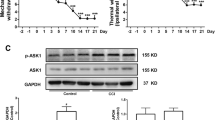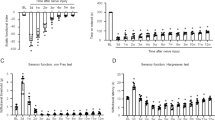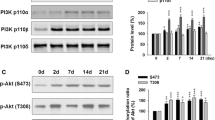Abstract
Neuropathic pain occurs due to deleterious changes in the nervous system caused by a lesion or dysfunction. Currently, neuropathic pain management is unsatisfactory and remains a challenge in clinical practice. Studies have suggested that actin cytoskeleton remodeling may be associated with neural plasticity and may involve a nociceptive mechanism. Here, we found that the RhoA/LIM kinase (LIMK)/cofilin pathway, which regulates actin dynamics, was activated after chronic constriction injury (CCI) of the sciatic nerve. Treatments that reduced RhoA/LIMK/cofilin pathway activity, including simvastatin, the Rho kinase inhibitor Y-27632, and the synthetic peptide Tat-S3, attenuated actin filament disruption in the dorsal root ganglion and CCI-induced neuropathic pain. Over-activation of the cytoskeleton caused by RhoA/LIMK/cofilin pathway activation may produce a scaffold for the trafficking of nociceptive signaling factors, leading to chronic neuropathic pain. Here, we found that simvastatin significantly decreased the ratio of membrane/cytosolic RhoA, which was significantly increased after CCI, by inhibiting the RhoA/LIMK/cofilin pathway. This effect was highly dependent on the function of the cytoskeleton as a scaffold for signal trafficking. We conclude that simvastatin attenuated neuropathic pain in rats subjected to CCI by inhibiting actin-mediated intracellular trafficking to suppress RhoA/LIMK/cofilin pathway activity.










Similar content being viewed by others
References
Jensen TS, Finnerup NB (2014) Allodynia and hyperalgesia in neuropathic pain: clinical manifestations and mechanisms. Lancet Neurol 13:924–935. doi:10.1016/s1474-4422(14)70102-4
Bishop AL, Hall A (2000) Rho GTPases and their effector proteins. Biochem J 348:241–255
Shimokawa H, Rashid M (2007) Development of Rho-kinase inhibitors for cardiovascular medicine. Trends Pharmacol Sci 28:296–302. doi:10.1016/j.tips.2007.04.006
Mueller BK, Mack H, Teusch N (2005) Rho kinase, a promising drug target for neurological disorders. Nat Rev Drug Discov 4:387–398. doi:10.1038/nrd1719
Rosso S, Bollati F, Bisbal M, Peretti D, Sumi T, Nakamura T, Quiroga S, Ferreira A, Cáceres A (2004) LIMK1 regulates Golgi dynamics, traffic of Golgi-derived vesicles, and process eExtension in primary cultured neurons. Mol Biol Cell 15:3433–3449. doi:10.1091/mbc.E03-
Harms KJ, Dunaevsky A (2007) Dendritic spine plasticity: looking beyond development. Brain Res 1184:65–71. doi:10.1016/j.brainres.2006.02.094
Woolf CJ, Salter MW (2000) Neuronal plasticity: increasing the gain in pain. Science 288:1765–1768
Bezanilla M, Gladfelter AS, Kovar DR, Lee WL (2015) Cytoskeletal dynamics: a view from the membrane. J Cell Biol 209:329–337. doi:10.1083/jcb.201502062
Tan AM, Stamboulian S, Chang YW, Zhao P, Hains AB, Waxman SG, Hains BC (2008) Neuropathic pain memory is maintained by Rac1-regulated dendritic spine remodeling after spinal cord injury. J Neurosci 28:13173–13183. doi:10.1523/JNEUROSCI.3142-08.2008
Ikeda H, Stark J, Fischer H, Wagner M, Drdla R, Jäger T, Sandkühler J (2006) Synaptic amplifier of inflammatory pain in the spinal dorsal horn. Science 312:1659–1662
Chen LY, Rex CS, Casale MS, Gall CM, Lynch G (2007) Changes in synaptic morphology accompany actin signaling during LTP. J Neurosci 27:5363–5372. doi:10.1523/JNEUROSCI.0164-07.2007
Bhave G, Gereau RW (2003) Growing pains. Neuron 39:577–579. doi:10.1016/s0896-6273(03)00500-2
Goldstein JL, Brown MS (1990) Regulation of the mevalonate pathway. Nature 343:425–430
Endres M (2006) Statins: potential new indications in inflammatory conditions. Atheroscler Suppl 7:31–35. doi:10.1016/j.atherosclerosissup.2006.01.005
Weitz-Schmidt G (2002) Statins as anti-inflammatory agents. Trends Pharmacol Sci 23:482–486
Pan HC, Yang DY, Ou YC, Ho SP, Cheng FC, Chen CJ (2010) Neuroprotective effect of atorvastatin in an experimental model of nerve crush injury. Neurosurgery 67:376–388. doi:10.1227/01.NEU.0000371729.47895.A0 (discussion 388-379)
Miranda HF, Noriega V, Olavarria L, Zepeda RJ, Sierralta F, Prieto JC (2011) Antinociception and anti-inflammation induced by simvastatin in algesiometric assays in mice. Basic Clin Pharmacol Toxicol 109(6):438–442
Cordle A, Koenigsknecht-Talboo J, Wilkinson B, Limpert A, Landreth G (2005) Mechanisms of statin-mediated inhibition of small G-protein function. J Biol Chem 280:34202–34209. doi:10.1074/jbc.M505268200
Bennett GJ, Xie YK (1988) A peripheral mononeuropathy in rat that produces disorders of pain sensation like those seen in man. Pain 33:87–107
Hargreaves K, Dubner R, Brown F, Flores C, Joris J (1988) A new and sensitive method for measuring thermal nociception in cutaneous hyperalgesia. Pain 32:77–88
Pogatzki EM, Zahn PK, Brennan TJ (2000) Lumbar catheterization of the subarachnoid space with a 32-gauge polyurethane catheter in the rat. Eur J Pain 4:111–113. doi:10.1053/eujp.1999.0157
Ohsawa M, Mutoh J, Hisa H (2008) Mevalonate sensitizes the nociceptive transmission in the mouse spinal cord. Pain 134:285–292. doi:10.1016/j.pain.2007.04.031
Li Y, Hu F, Chen H-J, Du Y-J, Xie Z-Y, Zhang Y, Wang J, Wang Y (2014) LIMK-dependent actin polymerization in primary sensory neurons promotes the development of inflammatory heat hyperalgesia in rats. Sci Signal 7:61
Arber S, Barbayannis FA, Hanser H, Schneider C, Stanyon CA, Bernard O, Caroni P (1998) Regulation of actin dynamics through phosphorylation of cofilin by LIM-kinase. Nature 393:805–809
Budzyn K, Marley PD, Sobey CG (2006) Targeting Rho and Rho-kinase in the treatment of cardiovascular disease. Trends Pharmacol Sci 27:97–104. doi:10.1016/j.tips.2005.12.002
Buyukafsar K, Yalcin I, Kurt AH, Tiftik RN, Sahan-Firat S, Aksu F (2006) Rho-kinase inhibitor, Y-27632, has an antinociceptive effect in mice. Eur J Pharmacol 541:49–52. doi:10.1016/j.ejphar.2006.04.042
Inoue M, Rashid MH, Fujita R, Contos JJ, Chun J, Ueda H (2004) Initiation of neuropathic pain requires lysophosphatidic acid receptor signaling. Nat Med 10:712–718. doi:10.1038/nm1060
Yoshimi E, Kumakura F, Hatori C, Hamachi E, Iwashita A, Ishii N, Terasawa T, Shimizu Y, Takeshita N (2010) Antinociceptive effects of AS1892802, a novel Rho kinase inhibitor, in rat models of inflammatory and noninflammatory arthritis. J Pharmacol Exp Ther 334:955–963. doi:10.1124/jpet.110.167924
Yoshimi E, Yamamoto H, Furuichi Y, Shimizu Y, Takeshita N (2010) Sustained analgesic effect of the Rho kinase inhibitor AS1892802 in rat models of chronic pain. J Pharmacol Sci 114:119–122. doi:10.1254/jphs.10158SC
Bernard O (2007) Lim kinases, regulators of actin dynamics. Int J Biochem Cell Biol 39:1071–1076. doi:10.1016/j.biocel.2006.11.011
Yang N, Higuchi O, Ohashi K, Nagata K, Wada A, Kangawa K, Nishida E, Mizuno K (1998) Cofilin phosphorylation by LIM-kinase 1 and its role in Rac-mediated actin reorganization. Nature 393:809–812. doi:10.1038/31735
Salvarezza SB, Deborde S, Schreiner R, Campagne F, Kessels MM, Qualmann B, Caceres A, Kreitzer G, Rodriguez-Boulan E (2009) LIM kinase 1 and cofilin regulate actin filament population required for dynamin-dependent apical carrier fission from the trans-Golgi network. Mol Biol Cell 20:438–451. doi:10.1091/mbc.E08-08-0891
Mittal N, Roberts K, Pal K, Bentolila LA, Fultz E, Minasyan A, Cahill C, Pradhan A, Conner D, DeFea K, Evans C, Walwyn W (2013) Select G-protein-coupled receptors modulate agonist-induced signaling via a ROCK, LIMK, and beta-arrestin 1 pathway. Cell Rep 5:1010–1021. doi:10.1016/j.celrep.2013.10.015
Shi XQ, Lim TK, Lee S, Zhao YQ, Zhang J (2011) Statins alleviate experimental nerve injury-induced neuropathic pain. Pain 152:1033–1043
Chen X-Y, Li K, Light AR, Fu K-Y (2013) Simvastatin attenuates formalin-induced nociceptive behaviors by inhibiting microglial RhoA and p38 MAPK activation. J Pain 14:1310–1319
Miranda HF, Noriega V, Olavarria L, Zepeda RJ, Sierralta F, Prieto JC (2011) Antinociception and anti-inflammation induced by simvastatin in algesiometric assays in mice. Basic Clin Pharmacol Toxicol 109:438–442
Acknowledgments
This work was supported by the Grants of National Natural Science Foundation Committee of China (31070930 and 81200869). The authors are grateful to all study participants.
Author information
Authors and Affiliations
Corresponding author
Rights and permissions
About this article
Cite this article
Qiu, Y., Chen, W.Y., Wang, Z.Y. et al. Simvastatin Attenuates Neuropathic Pain by Inhibiting the RhoA/LIMK/Cofilin Pathway. Neurochem Res 41, 2457–2469 (2016). https://doi.org/10.1007/s11064-016-1958-1
Received:
Revised:
Accepted:
Published:
Issue Date:
DOI: https://doi.org/10.1007/s11064-016-1958-1




